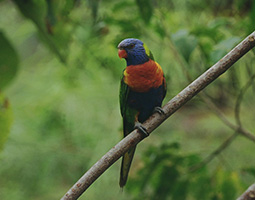Trichoglossus moluccanus
Description

The Rainbow Lorikeet, found in northern and eastern Australia, is at home in a wide range of habitats including rainforests, woodlands and urban areas. This noisy bird with its colourful plumage and bright red beak makes it one of the most recognisable birds in Australia. Males and females are similar in appearance, with a blue head and belly, green wings, tail and back, and an orange and yellow breast.
While there is some seasonal movement, the Rainbow Lorikeet is generally sedentary. They nest in hollow limbs of eucalypt trees from June to January, creating a nest of chewed, decayed wood. Both sexes work together to create the nest and feed the young, but only the female incubates the eggs, usually only two eggs are laid.
The call of a Rainbow Lorikeet is a loud screeching or chattering.
Adaptations
Short, strong legs and flexible hips, as well as two pairs of split claws on each leg which allow them to freely swing and hang upside down when foraging
Tend to fly in pairs or large flocks giving effective protection for the birds and their territory
The tip of a lorikeet's tongue contains an appendage (a projecting part) that is brush like and aids in efficiently enabling the bird to feed on nectar and pollen and also fruits
Feeding relationships
- What I eat: nectar and pollen from trees and shrubs; fruits; seeds and some insects
- What eats me: Peregrine falcons, Brown falcons, Whistling kites and pythons
Interesting facts
During hot weather in Darwin, many lorikeets appear drunk, running into things and having difficulty flying. It's not known whether it's caused by the alcohol content of fermenting fruit that they consume or a virus. Wildlife carers are becoming increasingly worried about these signs and symptoms.
Acknowledgment: Birdlife, Australian Museum, Australian Geographic, Australian Animal Learning Zone, Australian Plant and Animal Adaptations